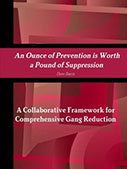An Ounce of Prevention is Worth a Pound of Suppression: A Collaborative Framework for Comprehensive Gang Reduction

Author: Dave Barciz
Publisher: Raleigh, NC: Lulu Press, Inc., 2014. 259p.
Reviewer: James C. Howell | September 2014
This engaging book reports both the program process and outcomes of an implementation of the federal Office of Juvenile Justice and Delinquency Prevention’s (OJJDP) Comprehensive Community-Wide Approach to Gang Prevention, Intervention, and Suppression (called the Comprehensive Gang Program Model, for short) in Raleigh, North Carolina. This program model calls for deployment of a combination of prevention, intervention, and suppression components in a flexible manner, utilizing five integrated strategies. Social Intervention and Opportunities Provision activities are primarily delivered within the context of a multidisciplinary intervention team composed of personnel from several agencies including street outreach, law enforcement, social services, probation/parole, and education. Community Mobilization engages members of the community in addressing local gang issues. Suppression activities emphasize accountability and community safety. Last, Organizational Change and Development activities seek to improve information sharing between agencies and the delivery of services to gang members and their families. When implemented with fidelity (National Gang Center, 2010), this program model has proved to be effective in several cities, including Chicago and Los Angeles (Hayeslip & Cahill, 2009; Spergel, Wa, & Sosa, 2006).
Implementation of the OJJDP Comprehensive Gang Program Model in Raleigh was led by the book’s author, Mr. Dave Barciz, the Project 110% Coordinator. Funding for this project ($990,000 for a 42-month period) came from the U.S. Department of Justice’s Comprehensive Anti-Gang Initiative. Although Raleigh’s gang problem has a relatively short history, dating back only to the 1990s, more than 2,000 gang members were validated by the city’s police department in 2006, and 14 gang-related homicides were reported that year. In recent years, about 30% of total homicides in Raleigh were gang-related.
In his position as Project 110% Coordinator, Mr. Barciz laid out six steps that his assembled team followed in implementing the OJJDP Comprehensive Gang Program Model. Other sites could benefit greatly from the practical value of these tips.
First, move away from a county- or city-wide initiative to a neighborhood-focused effort. A community assessment of the gang problem is required at the outset in order to adapt the Comprehensive Gang Program Model to local gang problems. From the assessment, the project identified two zip codes to be served, areas 27601, and 27610, from which came the name—drawn from the three underlined digits in each zip code: Project 110%, and also signifying the level of effort anticipated, more than 100%. The two zip code areas were home to one-half of Raleigh’s 2,000 gang members (representing mainly 4 gangs), nearly 100 arrest incidents in each month of 2006 (involving an average of 10 gang member crime victimizations each month), regular re-entry of violent gang-involved criminals (with 137 awaiting re-entry services), and home to a sizeable proportion of school-suspended youth and juvenile delinquents adjudicated in the Wake County Juvenile Court in 2006.
Second, determine the area’s community stressors that significantly increase gang exposure. In Raleigh, prominent stressors included youth entering the school-to-prison pipeline with long-term school suspensions, teenage mothers, returning inmates, and families in need of food, housing, and utility assistance.
Third, begin with a two-part coordinated strategy to address selected stressors. A dual Intervention-Enforcement Strategy was undertaken, the aim of which was to coach service providers and law enforcement to work collaboratively, and create a community “win” in the near-term in addressing selected community stressors, while building community support for enforcement’s suppression role. This strategy worked.
Fourth, use a logic model to develop a long-term strategic plan. This exercise revealed several service providers that were not addressing clearly defined needs or measuring the effectiveness of their programs.
Fifth, build a continuum of needed services. This strategy called upon PIRE (Prevention, Intervention, Re-entry, and Enforcement) partners to integrate services in full collaboration with one another. A key mechanism was “Cross Talk”, monthly partnership meetings to talk across the artificial barriers to integrated PIRE functions. These ingenious discussions led to important organizational changes that increased hard-to-reach-clients’ access to service and improved the tailoring of services to match their unique needs.
These step-by-step actions culminated in a Project 110% structure (page 170) that is virtually identical to the ideal recommended for sites that implement the OJJDP Comprehensive Gang Program Model (National Gang Center, 2010): consisting of a Steering Committee, a Project Coordinator, an Intervention Team with Outreach, and a Research Partner. While most local efforts think of at-risk and gang –embedded individuals as the problems to be fixed, the Project 110% model sees such individuals as part of the solution. Successful participants in Project 110% opportunities form the Developer Team, who recruit new participants, give honest feedback of strategy effectiveness, and act as peer role models and mentors to those awaiting services. On several occasions, an Ad-Hoc Team is formed to address urgent or temporary issues. Unusual service requirements required unique responses.
Project 110% project provided a broad spectrum of services for specific groups of youth and adults in the focus area (two zip codes) with elevated gang violence. Those targeted include potential victims, high risk youth, both non-violent and violent criminal gang members, incarcerated or deported gang members, and inmates returning from confinement. Parallel services consisted of global prevention, targeted prevention, intervention, law enforcement suppression, intensive intervention, and supportive interpersonal networks. The integration of this comprehensive matrix of targeted groups and services is largely attributable to the systematic procedure described briefly above, but the intervention team that Mr. Barciz led deserves much of the credit. Structured more broadly than the typical Comprehensive Gang Program Model intervention team, it integrated Prevention, Intervention, Re-entry, and Enforcement Partners with Outreach Workers. Again, more broadly than is usually the case, the Project 110% intervention team identified all high-risk individuals in the target area as its priority clients. Altogether more than 1,000 individuals and their families received services in the 4-year funded period.
In this large-scale undertaking, Project 110% set out to achieve several lofty goals, to make collaboration the norm among service providers, to lower barriers to services, to encourage sustainability, to alter criminal trajectories of individuals, and to reduce crime in the target area. It is apparent from the few examples which follow, that each of these goals was accomplished to a large degree in a four-year period in a high-crime and impoverished area. Collaborative problem solving became the norm among many service providers, shifting from “silo” maintenance to “team-player” service delivery. Many service providers no longer disqualify applicants with criminal backgrounds and gang affiliations.
The Project 110% collaborative remains active and agencies continue to address 10 community stressors that were identified as “gang developers.” More than 200 target youth returned to high school, 88 of which have earned GED’s with 50 more expected to follow. It is readily apparent that Project 110% programming built social capital for gang members (e.g., schooling, job training, and employment).
Gang crime, including violence, decreased significantly from 2008 to 2012 in the Project 110% focus area in comparison with the city as a whole. Gang-related crimes were reduced sharply, by 43% both in the target area and city-wide, including murders, which decreased from 14 in 2008 to just 2 in 2011. In the year prior to Project 110%, 5% of all crimes city-wide were gang-related, and these were cut in half by 2012 (to 2.5%). Not surprising then, the project demonstrated cost benefits. For every $1 spent on Project 110%, there was a $135 reduction in the cost of gang-related crime in the focus area, and a $325 impact in Raleigh as a whole.
The implementation process developed for Project 110% is creative, and a very useful guide for those working with the Comprehensive Gang Program Model elsewhere. This book, containing more than 250 pages of step-by-step details, is organized in a very user-friendly manner, of great benefit in particular to localities without any experience in implementing the OJJDP Comprehensive Gang Program Model. The author creatively sprinkles his book with sidebars (extraneous information of relevance), caveats (beware sorts of cautions), and analogies (thought-provokers). He effectively uses these in a teaching manner, while thoroughly engaging the reader in the step-by-step process. In addition, the data-driven strategic planning with Raleigh and Wake County law enforcement in the target area and in collaboration with intervention strategies and programs is very impressive — a model for other jurisdictions to emulate.
References
Hayeslip, D., & Cahill, M. (2009). Community Collaboratives Addressing Youth Gangs: Final Evaluation Findings from the Gang Reduction Program. Washington, DC: Urban Institute.
National Gang Center (2010). Best Practices to Address Community Gang Problems: OJJDP’s Comprehensive Gang Model. Washington, DC: Author.
Spergel, I. A., Wa, K. M., & Sosa, R. V. (2006). The comprehensive, community-wide, gang program model: Success and failure. In J. F. Short & L. A. Hughes (eds.), Studying Youth Gangs (pp. 203–224). Lanham, MD: AltaMira Press.


